博文
[转载]病毒进化学家贝德福德(Trevor Bedford)关于新冠病毒奥密克戎变异株的判断
||
The novel B.1.1.529 SARS-CoV-2 variant was designated Omicron (奥秘克戎) on the 26th November 2021, following its increasing prevalence in South Africa. Harbouring more than 30 mutations in its Spike protein, the principal concerns surround Omicron’s infectivity, virulence and ability to circumvent vaccine protection. Systematic virus isolation studies can provide important additional information, such as the serotype variability(血清型变异) among isolates. Knowledge of viral serotype variability is crucial to determine if antibodies derived from a previous SARS-CoV-2 infection or vaccine can protect from reinfection.
From Twitter by Trevor Bedford:
It seems that the common assumption has been that Omicron will displace Delta, just as Delta displaced Alpha, Beta, Gamma, etc... before it. This may well be the case, but it's by no means definite.
Depending on Omicron's mix of intrinsic transmissibility and immune escape (and what happens with continued evolution), we could see:
1. Displacement of Delta by Omicron 奥秘克戎取代德尔塔;
2. Long-term co-circulation 奥秘克戎与德尔塔“共存”;
3. Omicron wave followed by resurgence of Delta and extinction of Omicron 奥密克戎流行一波后,德尔塔卷土重来并重新挤掉奥秘克戎。

Intuitively, the more immune escape Omicron has from Delta-specific immunity the more the two variants have distinct ecological niches and so are able to co-exist without stepping on each other's toes.
We can model this as a two-strain SIRS model with polarizing immunity (https://bedford.io/projects/mitii/models-and-serology/models.html#/12 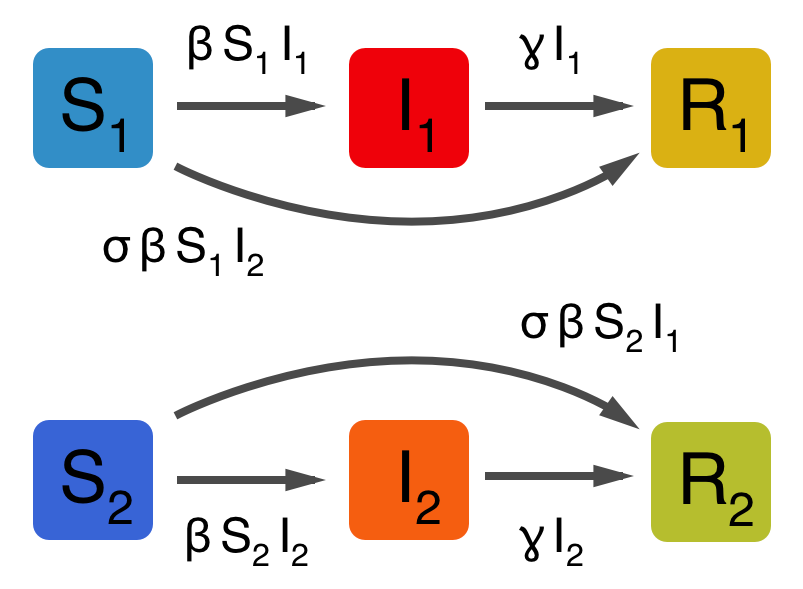
Here, β1 is transmission rate of strain 1, β2 is transmission rate of strain 2, γ is recovery rate, ω is rate of immune waning and σ is cross-immunity.
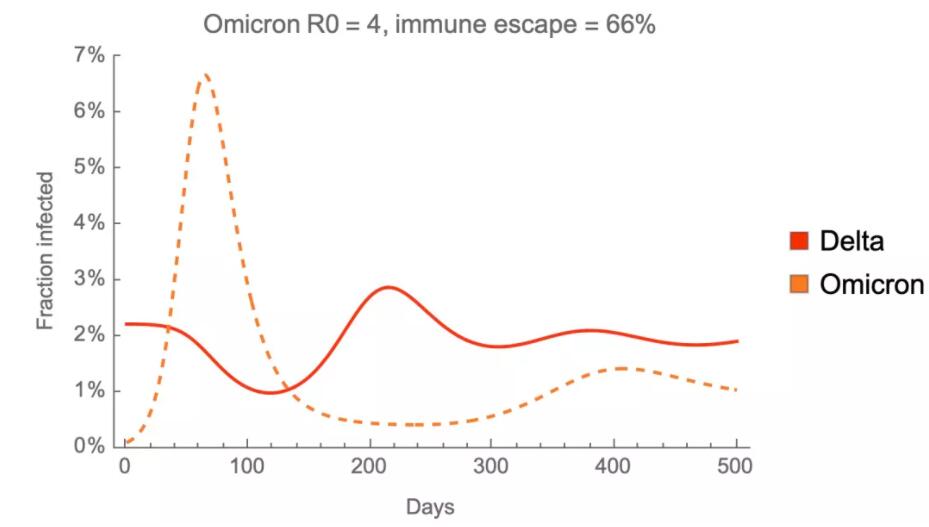
For these purposes, I assume that strain 1 (ie Delta) is at endemic equilibrium, where epidemic growth is balanced by population immunity, but where the strain continues to circulate due to waning immunity (ω = 1/365 per day).
The second strain (ie Omicron) is introduced and depending on its transmissibility β2 and its degree of immune escape 1-σ, it will spread more or less rapidly as described previously.
Assuming Delta R0 is 6, with lower intrinsic transmissibility and higher immune escape (Omicron R0 = 4, immune escape = 66%), Omicron has initial Rt of 2 and undergoes a large wave. However, this wave has relatively little impact on Delta.
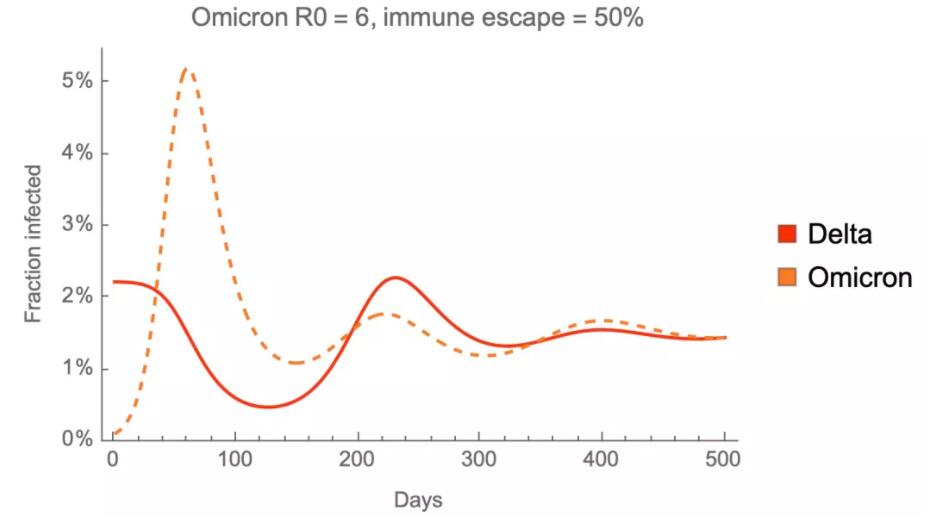
With moderate intrinsic transmissibility and immune escape (Omicron R0 = 6, immune escape = 50%), Omicron also has initial Rt of 2, a wave of similar magnitude, but more impact on Delta.
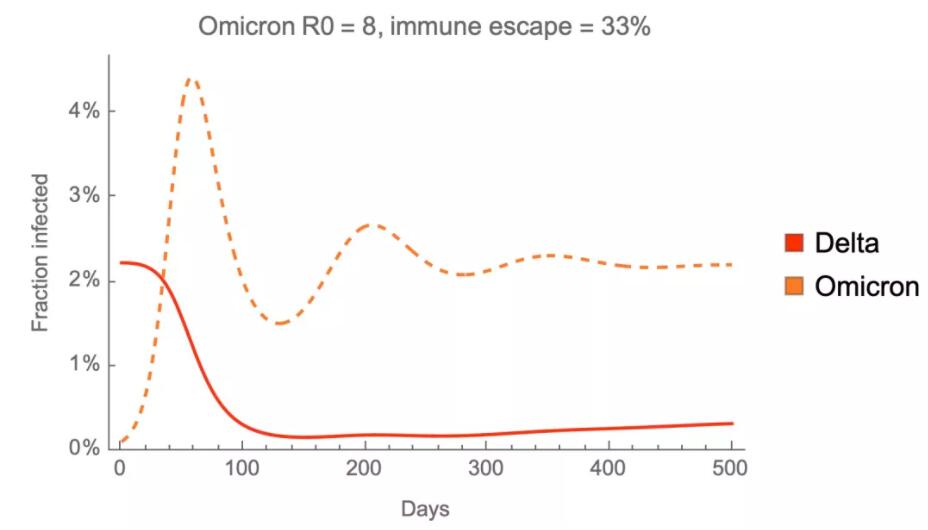
And with higher intrinsic transmissibility and lower immune escape (Omicron R0 = 8, immune escape = 33%), Omicron's wave really knocks down Delta.
In fact, we can plot out parameter combinations that result in scenario 1 (extinction of Delta, yellow), scenario 2 (co-circulation of Delta and Omicron, light gray) and scenario 3 (extinction of Omicron after epidemic wave, dark gray).
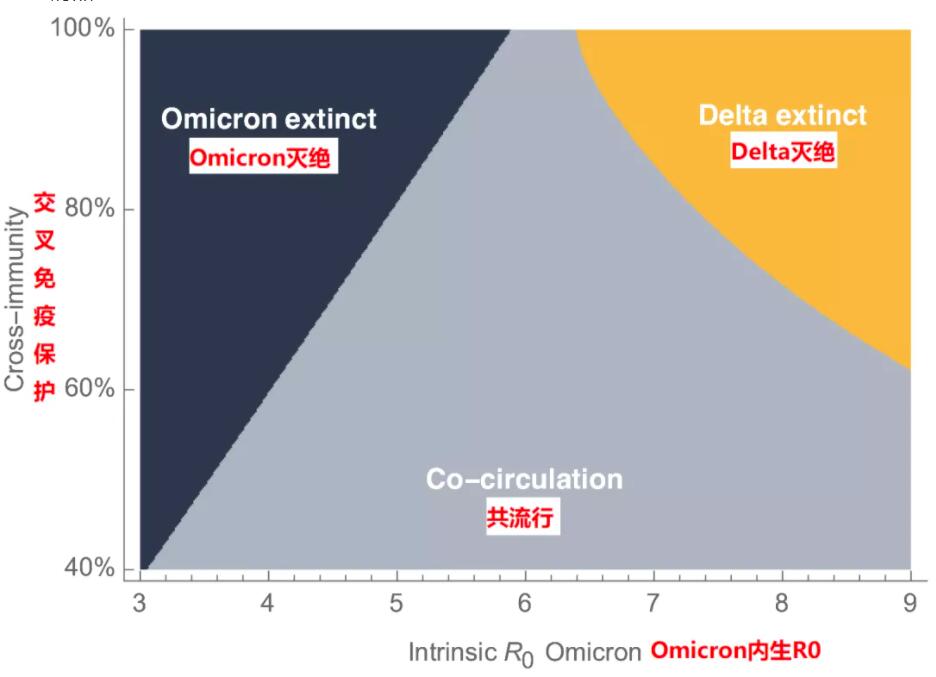
Co-circulation occurs when R0 is similar between Omicron and Delta and/or when there is little cross-immunity, and displacement occurs when there is strong cross-immunity and lopsided R0. See Restif and Grenfell for further discussion (royalsocietypublishing.org/doi/1...
If we compare to seasonal flu, displacement is largely the rule with new strains replacing existing diversity. However, we do have an example of scenario 2 with B/Victoria and B/Yamagata diverging around 1980 and co-circulating since (figure from elifesciences.org/articles/44205...
Although this question of displacement vs co-circulation is not immediately critical to pandemic understanding or public health response, its resolution will have significant impact on eventual endemic state of SARS-CoV-2.
If Omicron and Delta co-circulate then annual vaccines would be best formulated as multiple valencies (just like flu vaccine has both B/Victoria and B/Yamagata) and we can expect generally higher levels of viral circulation than in the displacement scenario.
I'm very much hoping we'll see displacement, but we should have first hint at outcome in the next few weeks as we see to what degree the Omicron wave reduces Delta circulation in the US and Europe.
以上转自:https://pingthread.com/thread/1470420195567030274
William Haseltine:“Omicron is sending a message, loud and clear: this virus is capable of far more changes and far more variation than most ever thought possible and it will keep coming back to haunt us again and again.”
"We will consider the modification option but as of now, our data shows that the vaccine is effective enough in neutralizing the most widely-spread virus serotypes(病毒的血清型)," the expert pointed out. "If we see that some new strains are spreading and the vaccine’s neutralizing capabilities are lacking against them, we will create [a vaccine] against that specific strain," Isayev assured.
A serotype is defined as one which either exhibits no cross-reaction with others, or shows a homologous/heterologous titer ratio greater than 16 (in both directions).
From: Virus Taxonomy, 2005
Understanding virus isolates, variants, and strains
by Vincent Racaniello
Many virology terms are being used these days by people who do not understand their meaning. Included are journalists, medical doctors, scientists, lawyers, and people from all walks of life. In normal times this word mis-usage would be so rare that it would not matter. However, because we are in a viral pandemic that affects nearly everyone, I will attempt to explain the meaning of virus isolates, variants, and strains.
Many of the terms used in virology are ill-defined. They have no universally accepted definitions and there is no ‘bible’ with the correct meanings. As each of us are trained by other virologists, we hear them using terms in certain contexts and we copy their usage – whether or not it is correct. I learned many good things from my mentors but also many things that are wrong.
Nevertheless, certain terms should have specific meanings. Some of my colleagues will certainly disagree with some of my definitions, others will agree. Kudos to the latter. I also recognize that few will read this post and it will have little impact. Perhaps one day a high school student will search for some of the terms and come across it. It is mainly meant for me to put my thoughts down in an orderly manner.
The virology terms I have in mind all have to do with attempts to place order on the huge varieties of viruses in the virosphere. Most of them today derive their meaning from the viral genome: the DNA or RNA that encodes the production of new virus particles. This reliance on the genome is relatively recent: until the 1980s we had no genome sequences; hence most categories were based on other properties, such as the size of the virus particle, whether or not it has a membrane, its type of symmetry, and much more. Today it’s all about the genome. Whether or not you think this myopia is a good idea is not the topic of this post.
Let’s start with the term virus isolate, because it’s the easiest to define. An isolate is the name for a virus that we have isolated from an infected host and propagated in culture. The first isolates of SARS-CoV-2 (新冠病毒)were obtained from patients with pnemonia in late 2019. A small amount of fluid was inserted into their lungs, withdrawn, and placed on cells in culture. The virus in the fluid reproduced in the cells and voila, we had the first isolates of the virus.
Virus isolate is a very basic term that implies nothing except that the virus was isolated from an infected host. An isolate comes from a single host. We can have my virus isolate, or yours, or the neighbor’s down the street. Most patients do not get to have virus isolates taken from them. Even though SARS-CoV-2 has infected millions, we do not have millions of isolates, probably just thousands. We do have genome sequences from many people, and those can be inferred to represent the isolate from each person – however in most cases infectious virus is not isolated from individual patients.
Isolates are given names so that their origin is known. For example, one of the early isolates of SARS-CoV-2 is called BetaCoV/W**/WIV04/2019. This isolate name consists of the genus, Betacoronavirus(乙型冠状病毒属), followed by the city of origin, the isolate number, and the year. SARS-CoV-2 is the name of the virus; it is not an isolate name. Isolates of other viruses are also precisely named. I’m a big fan of the very detailed influenza virus nomenclature, which is as follows: Virus name/antigenic type/host of origin if other than human/geographical origin/serial number/last two digits (or all four digits) of year of isolation/hemagglutinin subtype neuraminidase subtype. Examples include influenza A virus A/duck/Germany/1868/68 (H6N1) or influenza A virus A/chicken/Vietnam/NCVD- 404/2010 (H5N1).
A virus variant is an isolate whose genome sequence differs from that of a reference virus. No inference is made about whether the change in genome sequence causes any change in the phenotype of the virus. The meaning of variant has become clouded in the era of whole viral genome sequencing, because nearly every isolate may have a slightly different genome sequence. Such is the case for SARS-CoV-2: nearly every sequence from a different person is slightly different. Up until the end of 2020, any SARS-CoV-2 sequences from any two individuals differed by about ten nucleotide changes out of 30,000. They are all variants, but the term is rarely used in this context. However since then viral genomes with many more changes have been identified. These have been called ‘variants of concern’ (VOC) because it is thought that the changes confer new phenotypic properties such as increased fitness. British scientists did a good deed by calling them VOCs, because now the press must call them variants.
Unfortunately mainstream media, following in the footsteps of scientists who really should know better, have been using the term ‘strain’ to describe what are actually variants. This practice emerges in every viral outbreak: there is a new, more (fill in the blank with your favorite phenotype) strain of Ebolavirus, of Zika virus, and now of SARS-CoV-2. It began early in 2020 with the finding of variants with a single amino acid change in the spike protein, from D to G at position 614. The press called this a new strain that was more transmissible. But the use of strain was incorrect: it is a variant and remains so to this day.
A virus strain is a variant that possesses unique and stable phenotypic characteristics. Such characteristics can only be ascertained by the results of experiments done in the laboratory, in cells in culture and in animals, coupled with observations made in infected humans. The name strain is not easily earned: certainly it cannot simply be given by journalists! As Jens Kuhn has written, “The designation of a virus variant as a strain would be the responsibility of international expert groups”. No such designation of strain has been given more than once to SARS-CoV-2: there is one, and only one strain of this virus. No incorrect usage of that term will change this fact. As you might imagine, it can take some time for an international group of experts to agree on anything.
Viral strains are few and far between: it is a designation highly desired but given sparingly. A retrovirologist recently assured me that there is only one strain of HIV-1. The Lansing strain of poliovirus is derived from a human isolate that was passaged 99 times in mice until it acquired the ability to infect that species. That strain has demonstrably different properties from the human strain.
There are other terms to describe viruses but they are more confusing than contentious, and they are not used universally. (血清分型) The term serotype is used to describe viruses of the same species that are antigenically different. There are three serotypes of poliovirus; if you are infected with type 1, then immunity you generate will not protect you against infection with types 2 or 3. Same for the four serotypes of dengue virus, and the hundreds of rhinovirus serotypes. These days, the genome sequence of the virus is used to infer whether isolates are serologically different. The term genotype (基因型)is used to describe the genetic makeup of a virus. For example, hepatitis C viruses are placed in different genotypes depending on the overall identity of their genomes. For other viruses, the term clade is used. A clade is a group of organisms composed of an ancestor and its descendants, as illustrated by the phylogenetic tree below. SARS-CoV-2 isolates and HIV-1 isolates are placed in clades based on phylogenetic trees constructed from their genome sequences.
I believe that the terms of virology should be used accurately and consistently. The terms isolate, strain, and variant have been frequently and incorrectly misused during the pandemic, which generates confusion. I have little faith that either the general public or the scientists will agree on any nomenclature. Rest assured that if you misuse isolate, variant, or strain, I will correct you according to my lexicon.
以上转自:https://www.virology.ws/2021/02/25/understanding-virus-isolates-variants-strains-and-more/
https://blog.sciencenet.cn/blog-446272-1316707.html
上一篇:新冠病毒变体研究Reduced neutralization of SARS-CoV-2 B.1.617 variant
下一篇:[转载]NEJM:开发广谱通用冠状病毒疫苗乃当务之急(Universal Coronavirus Vaccines)